| View previous topic :: View next topic |
| Author |
Message |
xaprb

Joined: 28 Jan 2021
Posts: 168
|
 Posted: Thu Apr 28, 2022 12:02 am Post subject: Unknown APO-SIGMA 400mm f5.6 Posted: Thu Apr 28, 2022 12:02 am Post subject: Unknown APO-SIGMA 400mm f5.6 |
 |
|
xaprb wrote:
I’ve just gotten a thrift-store copy of what I speculate is an early generation of Sigma’s 400mm f5.6 lenses, with ∑ in front of the serial number. I have seen three other generations of this lens that look very different from this one, but never this one, and can’t seem to find any information about it online.
The inscription on the focusing ring reads “APO-Sigma 1:5.6 f=400mm Multi-Coated ∑-xxxxxx Lens Made In Japan ø72” and it has a built-in sliding hood, rotating tripod collar, and internal focusing. It’s very nicely built, all metal, with the classic Sigma focus grip that had rectangular knurling with rows of Sigma logos and Sigma names. This copy is in impeccable condition except for heavy hazing behind a front element, so I can’t test it until I take it apart and clean that.
Here’s some photos.
#1

#2
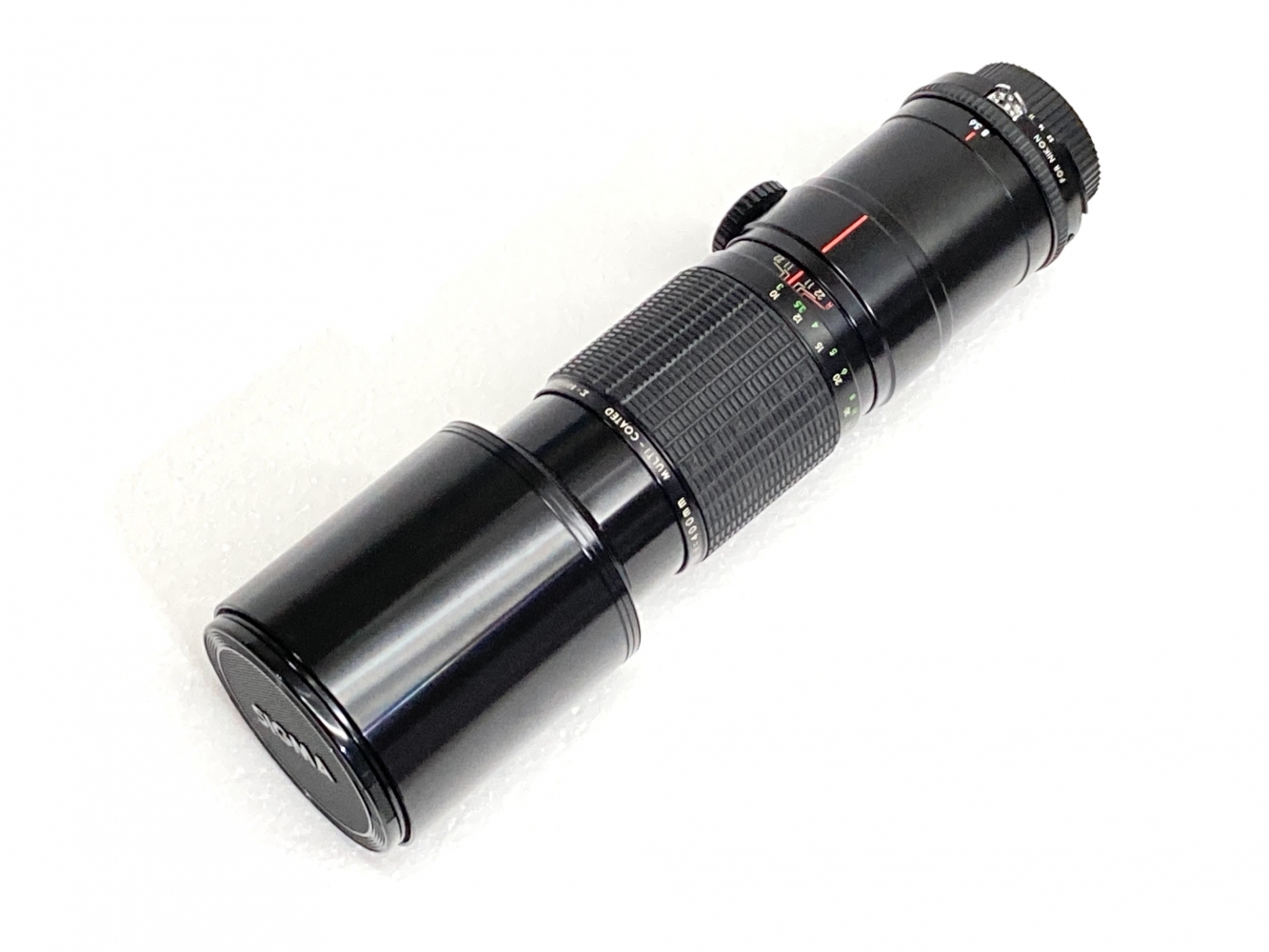
#3
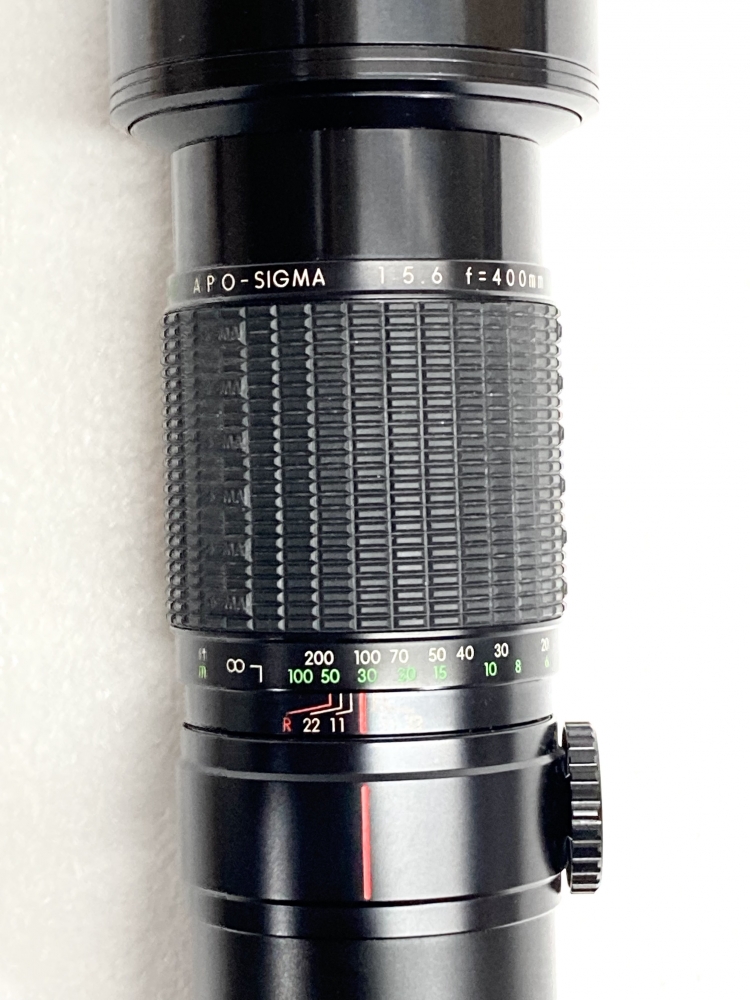 |
|
| Back to top |
|
 |
iangreenhalgh1


Joined: 18 Mar 2011
Posts: 15685
Expire: 2014-01-07
|
 Posted: Thu Apr 28, 2022 5:37 am Post subject: Posted: Thu Apr 28, 2022 5:37 am Post subject: |
 |
|
iangreenhalgh1 wrote:
Sadly, you probably won't be able to clean it. These Sigma 400mm lenses are mostly junk these days due to that element that hazes and can't be cleaned.
_________________
I don't care who designed it, who made it or what country it comes from - I just enjoy using it! |
|
| Back to top |
|
 |
xaprb

Joined: 28 Jan 2021
Posts: 168
|
 Posted: Thu Apr 28, 2022 11:19 am Post subject: Posted: Thu Apr 28, 2022 11:19 am Post subject: |
 |
|
xaprb wrote:
Alas! I hope mine is an exception.
Does anyone know about the provenance and history of this particular variant? To me, the styling and build looks like an earlier lens than, say, the first AF versions. I am under the impression that the lenses whose serial numbers begin ∑ are earlier; perhaps late 1970s and early 1980s. But it’s marked APO-SIGMA, which surprises me; I didn’t think they made any APO lenses until later. I’m not sure how to reconcile these bits.
By the way, it has 4m minimum focus marking.
I’m comparing this to the lens-db entries for the various AF and MF lenses, eg https://lens-db.com/sigma-400mm-f56-1987/
There’s one entry for a manual-focus APO but it cites 3m MFD and there’s no photo: https://lens-db.com/sigma-mf-400mm-f56-apo-1981/ I suppose this could be my lens.
I haven’t found any other evidence of this lens’s existence online! |
|
| Back to top |
|
 |
iangreenhalgh1


Joined: 18 Mar 2011
Posts: 15685
Expire: 2014-01-07
|
 Posted: Thu Apr 28, 2022 1:23 pm Post subject: Posted: Thu Apr 28, 2022 1:23 pm Post subject: |
 |
|
iangreenhalgh1 wrote:
My fingers are crossed for you to be able to sort it out.
I'd say it was late 70s or very early 80s, but I'm just guessing.
_________________
I don't care who designed it, who made it or what country it comes from - I just enjoy using it! |
|
| Back to top |
|
 |
eggplant


Joined: 27 May 2020
Posts: 516
|
 Posted: Thu Apr 28, 2022 5:05 pm Post subject: Posted: Thu Apr 28, 2022 5:05 pm Post subject: |
 |
|
eggplant wrote:
| xaprb wrote: |
Alas! I hope mine is an exception.
Does anyone know about the provenance and history of this particular variant? To me, the styling and build looks like an earlier lens than, say, the first AF versions. I am under the impression that the lenses whose serial numbers begin ∑ are earlier; perhaps late 1970s and early 1980s. But it’s marked APO-SIGMA, which surprises me; I didn’t think they made any APO lenses until later. I’m not sure how to reconcile these bits.
By the way, it has 4m minimum focus marking.
I’m comparing this to the lens-db entries for the various AF and MF lenses, eg https://lens-db.com/sigma-400mm-f56-1987/
There’s one entry for a manual-focus APO but it cites 3m MFD and there’s no photo: https://lens-db.com/sigma-mf-400mm-f56-apo-1981/ I suppose this could be my lens.
I haven’t found any other evidence of this lens’s existence online! |
I can offer some illumination here- this is not too unknown. Whilst I have product brochures that can map the history of the Sigma 400mm offerings, we are fortunate to have detailed information from Ohsone's Anecdotes, which cover this extensively- https://www.sigma-sein.com/en/ohsone/ultratelephotolenses_1/ https://www.sigma-sein.com/en/ohsone/ultratelephotolenses_2/
I will start from the 'beginning'.
1st - SIGMA XQ 400mm F5.6, 1976-1980~
| Quote: |
SIGMA demonstrated its unique personality here as well and became pioneers when, in 1976, they released a lens with internal focus: the SIGMA XQ 400mm F5.6. Unfortunately, the SLR era’s first product of inner focus was Canon’s FD 400mm f / 4.5. But I am simply amazed by the courage and hard work of the lens designers who realized an internal focus with a lens design consisting of only four groups with four elements. The internal focusing mechanism allowed for smooth and easy focusing, and together with its reasonable price the lens became a hit product for SIGMA. With minimal changes like an improved minimum focusing distance and the new name ULTRA-TELE 400mm F5.6, the lens remained available in stores up until 1980.
The 400mm F5.6 was intentionally lengthened to mitigate the power of the first lens group and keep the chromatic aberrations at an absolute minimum. However, one has to admit that the chromatic aberrations were not suppressed sufficiently. SIGMA did not release another refractor-type lens with a focal length higher than 400mm until they had found a way to reduce chromatic aberrations sufficiently. That’s how much SIGMA disliked losing resolution to chromatic aberrations. |
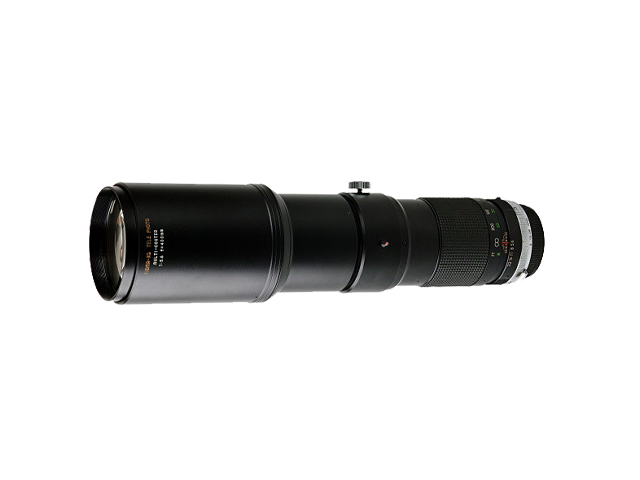
I don't know the date of this guidebook, but it's clearly not a later one as it's still titled "Sigma XQ Lenses"
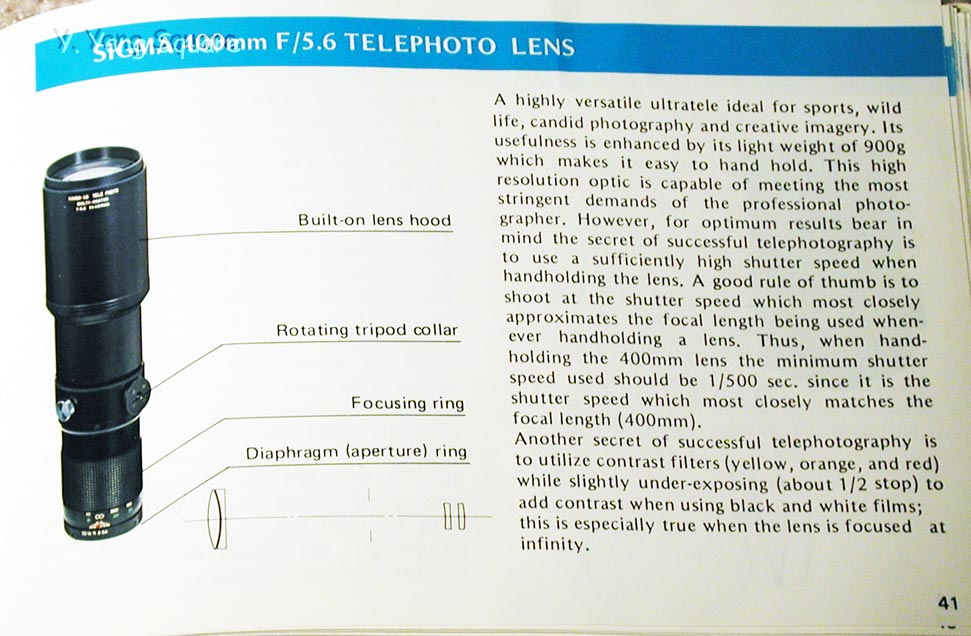
A very interesting brochure I own, "Sigma- the lens maker" from 1980, containing both earlier XQ lenses (e.g. 39-80mm f3.5) and later line (e.g. 21-35mm) at once, in XQ trim, still lists it. Indeed, as Ohsone says, the optical design is changed a fair bit. Also note "Super-tele" rather than "Ultra-tele", although I'm sure it could've been called both.


Last edited by eggplant on Sun May 01, 2022 1:18 pm; edited 1 time in total |
|
| Back to top |
|
 |
eggplant


Joined: 27 May 2020
Posts: 516
|
 Posted: Thu Apr 28, 2022 5:11 pm Post subject: Posted: Thu Apr 28, 2022 5:11 pm Post subject: |
 |
|
eggplant wrote:
2nd - APO-SIGMA 400mm F5.6, 1981- ???. I would go by how the next model was released in late 1986 (Ohsone).
This is your lens.
Emphasis added by me. Quote from Ohsone:
| Quote: |
How do we get rid of chromatic aberrations? This is a problem lens designers are still grappling with today. One method to correct chromatic aberrations is to use a so-called dense-flint apochromat, a technique often used in astronomical telescopes. An apochromat comprises three lens elements – two of them made of dense-flint glass – that bring three different wavelengths into focus. While effective, the method poses several problems. The required curvature of the lenses is quite large, resulting in thick and heavy lenses. The large curvature also makes it difficult to correct any aberrations but chromatic aberrations. Further, the process of combining three lenses with large apertures into a single unit is quite difficult. For these reasons, although some manufacturers tried to implement apochromats in their exchangeable lens designs, the technique did not become mainstream.
Companies like Canon and Nikon developed the know-how to reduce chromatic aberrations by using low-dispersion glass or artificial fluorite, and in the 1970s, high-performance lenses with reduced chromatic aberrations began to replace the previous ultra telephoto lenses. SIGMA had no choice but to keep up with these developments. However, at the time SIGMA lacked the funds and the technologically to begin development of the necessary materials.
Instead, SIGMA decided to enter the fray by employing dense-flint apochromats. In 1981, SIGMA released the APO SIGMA345 300mm F4.5 and the APO SIGMA456 400mm F5.6, both of which made use of the apochromat technique. The two lenses were widely discussed and became a huge boost to the company’s brand image. However, the manufacturing factory had problems accurately polishing the large-aperture lenses and glueing the three elements together into a single apochromatic lens. The yield rate was poor and the prices jumped high enough to equal lenses of camera manufacturers. |
So- Sigma didn't have access to special low-dispersion glass, and decided to enter the market anyway with a dense-flint apochromat, which is tricky to get right.
Here we can read from a "Sigma lenses" brochure/booklet I've yet to buy, some time into the 1980s with Sigma's new line, which describes exactly this from Ohsone, and shows the design of the lens:

Crop + slight upscale:
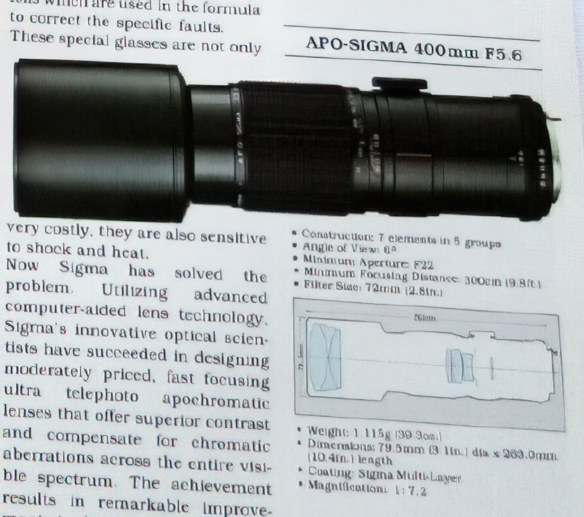
Transcribing the relevant parts:
| Quote: |
APO SIGMA 400mm f5.6
...
The exceptional imaging quality is due to the innovative use by Sigma's optical engineers of high density flint crown optical glass, instead of low dispersion or fluorite types, to produce this superbly corrected long telephoto in which all three colors, instead of just two, are precisely focused on the same plane.
New Sigma Apochromatic Lenses Made of Standard Optical Glass
When designing extremely compact ultra-long focal length lenses, the elimination of chromatic aberrations becomes increasingly difficult and expensive. The problem is normally solved by compromising the corrections of the image-deteriorating aberrations by using fluorite glass or low dispersion glass for those elements of the lens which are used in the formula to correct specific faults. These special glasses are not only very costly, they are also sensitive to shock and heat.
Now Sigma has solved the problem. Utilizing advanced computer-aided lens technology, Sigma's innovative optical scientists have succeeded in designing moderately priced, fast focusing ultra telephoto apochromatic lenses that offer superior contrast and compensate for chromatic aberrations across the entire visible spectrum. |
|
|
| Back to top |
|
 |
xaprb

Joined: 28 Jan 2021
Posts: 168
|
 Posted: Thu Apr 28, 2022 6:06 pm Post subject: Posted: Thu Apr 28, 2022 6:06 pm Post subject: |
 |
|
xaprb wrote:
Thank you!! Where did you find the brochures? What a treasure trove of interesting historical data.
My favorite part might be "Look to the distant images that reveal universal truths and hidden beauty." I wonder who was responsible for THAT opus magnum of photographic marketing copywriting! I imagine if they were producing something for TV, it would be like the opening to an Indiana Jones movie. |
|
| Back to top |
|
 |
eggplant


Joined: 27 May 2020
Posts: 516
|
 Posted: Thu Apr 28, 2022 6:47 pm Post subject: Posted: Thu Apr 28, 2022 6:47 pm Post subject: |
 |
|
eggplant wrote:
| xaprb wrote: |
Thank you!! Where did you find the brochures? What a treasure trove of interesting historical data.
My favorite part might be "Look to the distant images that reveal universal truths and hidden beauty." I wonder who was responsible for THAT opus magnum of photographic marketing copywriting! I imagine if they were producing something for TV, it would be like the opening to an Indiana Jones movie. |
"Sigma XQ lenses" - http://forum.mflenses.com/sigma-xq-lenses-t73290.html
"Sigma- the lens maker" one is quick phone picture of my own copy, yet to scan in. I'm waiting on some scanning equipment- you can watch the "Library" section for updates.
The picture of the "Sigma lenses" mid 80s one is from an eBay listing I have on watch (shipping too high atm).
The Sigma XQ + Sigma- the lens maker ones both seem uncommon to be sold individually, the latter was bundled with a lens and I snapped it up. I've only ever seen one Sigma XQ lens brochure for sale individually.
The "Sigma lenses" mid 80s one is abit more common, but too high shipping costs at the moment.
I will complete the story of the Sigma 400mm f5.6 in the following post...  |
|
| Back to top |
|
 |
stevemark

Joined: 29 Apr 2011
Posts: 3754
Location: Switzerland
|
 Posted: Sat Apr 30, 2022 7:23 pm Post subject: Posted: Sat Apr 30, 2022 7:23 pm Post subject: |
 |
|
stevemark wrote:
Thanks a lot for all this valuable information and the extremely interesting link (which I wasn't aware of).
I have a later version of the Sigma 5.6/400mm APO with Minolta MD bayonet:

As many interesting Sigma lenses from its time, the lens is badly fogged. Therefore, after buying, I simply put it to the attic and forgot about it - for nearly ten years. Yesterday I took it down again, trying to establish some information about its performance. Originally it must have been quite a good lens, having much less CAs than the common 5.6/400mm and 4.5/400mm lenses of its time (e. g. Canon FD 4.5/400 or Konica Hexanon 4.5/400 etc). CAs are about at same level as the Canon nFD 2.8/400mm L, but not as good as the Minolta MC/MD 5.6/400mm (which was a fluorite lens). Detail resolution, however, is not as good as the Canon 2.8/400mm L. Quite good in the center (not too far from the Canon L actually), but quite inferior further out.
I really should clean it up, but other than the bayonet screws i can't see any screw to open the lens!! Interesting mechanical construction indeed ... does anyone have some information on repairing theses lenses? It should be similar to the contemporary* Sigma 7.2/500mm APO lenses which look almost exactly the same, just with a slightly longer barrel!
S
* I don't mean the "Sigma Contemporary" series of lenses here!!
_________________
www.artaphot.ch |
|
| Back to top |
|
 |
xaprb

Joined: 28 Jan 2021
Posts: 168
|
 Posted: Sat Apr 30, 2022 8:13 pm Post subject: Posted: Sat Apr 30, 2022 8:13 pm Post subject: |
 |
|
xaprb wrote:
I had the following in my notes about disassembly and cleaning/repair.
https://www.pbase.com/pganzel/repair_of_sigma_400mm_f56_apo
http://forum.mflenses.com/sigma-400mm-f5-6-apo-help-t48792.html
I have one partially disassembled but haven't finished it and put it back together. Some of the elements that fog with atomized and redeposited oil are far back in the barrel and hard to reach; needs a custom-made tool to unscrew the retaining rings, as I recall, and I haven't made one. |
|
| Back to top |
|
 |
marcusBMG

Joined: 07 Dec 2012
Posts: 1304
Location: Conwy N Wales
|
 Posted: Sun May 01, 2022 11:35 am Post subject: Posted: Sun May 01, 2022 11:35 am Post subject: |
 |
|
marcusBMG wrote:
That's great info on the successive generations of sigma 400's. That 1st gen apo is pretty uncommon IME, but an interesting lens. Lets see some pics...
I have looked at more than half a dozen of the 2nd gen 400mm apo's, all of them have shown at least some hazing of the doublet deep in the lens. I have a PKA mount one to play with, its performance is slightly, but distinctly, affected. There isn't too much difference in resolution between the apo lens and the very similar looking non apo 400mm f5.6 MC, which I have currently both as a MF lens and as an AF lens for pentax (the latter has a certain cachet due to having almost no competition as a "consumer" AF 400mm f5.6 for pentax, the Pentax FA 400mm f5.6 is a premium lens at 20 times the price). However the difference in fringing is striking, the 400mm MC is a fringing monster.
I have a CFD mount 400mm apo as my test-repair lens. It looks like getting to the hazed doublet is achievable, but then what? Is it separable and fixable?
BTW I have had some success with painters "fixative" spray to try to keep the markings on the barrel, but the best plan is to clean most of the inevitably deteriorating "zen" coating off with a rag and meths.
Crops, slightly resized, pentax KS2
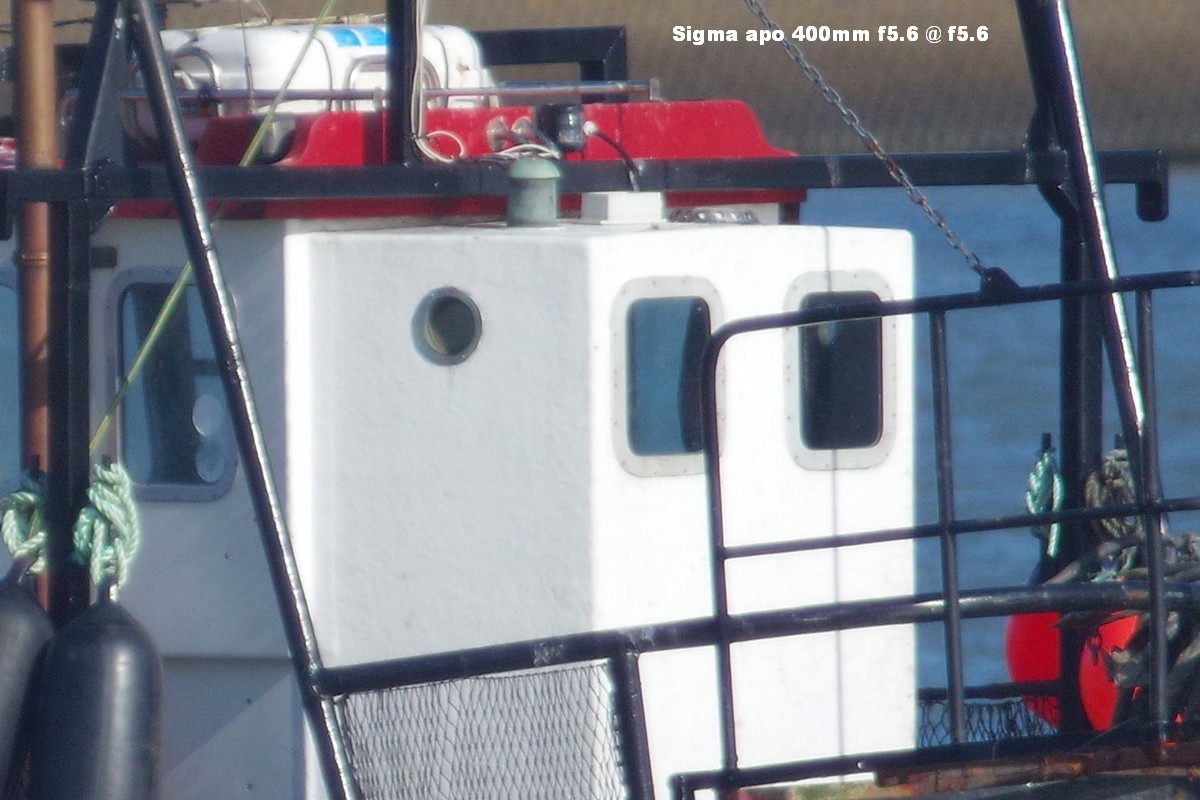

_________________
pentax ME super (retired)
Pentax K3-ii; pentax K-S2; Samsung NX 20; Lumix G1 + adapters;
Adaptall collection (proliferating!) inc 200-500mm 31A, 300mm f2.8, 400mm f4.
Primes: takumar 55mm; smc 28mm, 50mm; kino/komine 28mm f2's, helios 58mm, Tamron Nestar 400mm, novoflex 400mm, Vivitar 135mm close focus, 105mm macro; Jupiter 11A; CZJ 135mm.
A classic zoom or two: VS1 (komine), Kiron Zoomlock...
Last edited by marcusBMG on Sun May 01, 2022 11:47 am; edited 1 time in total |
|
| Back to top |
|
 |
xaprb

Joined: 28 Jan 2021
Posts: 168
|
 Posted: Sun May 01, 2022 11:46 am Post subject: Posted: Sun May 01, 2022 11:46 am Post subject: |
 |
|
xaprb wrote:
Interesting, I wonder how the Tamron 400mm f4 in your signature will compare against these at f5.6! |
|
| Back to top |
|
 |
stevemark

Joined: 29 Apr 2011
Posts: 3754
Location: Switzerland
|
 Posted: Sun May 01, 2022 12:31 pm Post subject: Posted: Sun May 01, 2022 12:31 pm Post subject: |
 |
|
stevemark wrote:
| xaprb wrote: |
| Interesting, I wonder how the Tamron 400mm f4 in your signature will compare against these at f5.6! |
Wide open i would be quite similar to the f5.6 shot from Sigma APO shown above (low contrast, but lots of detail). Maybe slightly more CAs though. Stopping down increases contrast.
(I don't onw the Tamron 4/400, but I've been testing a sample some years ago)
S
_________________
www.artaphot.ch |
|
| Back to top |
|
 |
eggplant


Joined: 27 May 2020
Posts: 516
|
 Posted: Sun May 01, 2022 1:34 pm Post subject: Posted: Sun May 01, 2022 1:34 pm Post subject: |
 |
|
eggplant wrote:
Interlude
Firstly - a number of Ricoh XR Rikenon lenses were rebadged from Sigma.
Out of the 'dense flint apochromat' designs, the 300mm f/4.5 was rebadged (but not the 400mm- a 400mm wasn't sold by Ricoh under the XR Rikenon line. The next in class was the Sigma 600mm f/8 mirror lens, rebadged).
This is pulled from my Rikenon XR lenses catalog (not scanned in yet), which opted to include the lens diagrams I've seen missing in otherwise identical brochures.
Even if they weren't there, the specifications and appearance are completely identical to the APO-SIGMA 300mm f/4.5, bar obvious colour changes.

Secondly- it appears other manufacturers adopted this 'dense-flint apochromat' design technique. I don't have comprehensive knowledge here, but its very clearly adopted for the 35mm Fujinon 400mm f/4.5 and 600mm f/5.6. Diagrams for these are online but in poor quality.
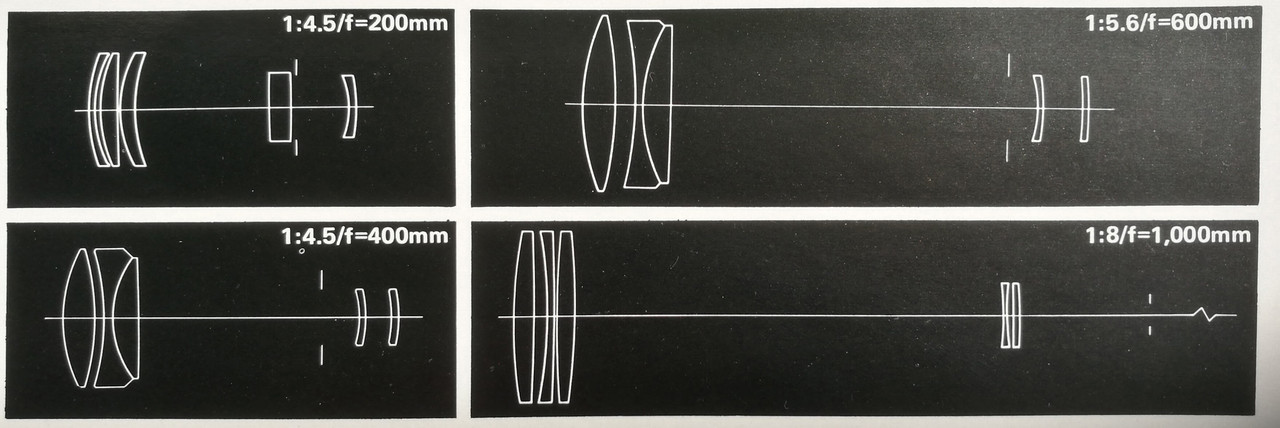
Interestingly - there is no mention of APO performance or dense-flint apochromats anywhere in the Fujinon brochure. |
|
| Back to top |
|
 |
marcusBMG

Joined: 07 Dec 2012
Posts: 1304
Location: Conwy N Wales
|
 Posted: Sun May 01, 2022 2:03 pm Post subject: Posted: Sun May 01, 2022 2:03 pm Post subject: |
 |
|
marcusBMG wrote:
Interestingly, I think the Itoh made (palinar and other marques of the 1960's) 400mm f6.3 is of this dense-flint design - a fat triplet objective similar to the diagram for the 600mm above. it certainly seems quite well corrected. I have some test pics against a pentax M 400mm f5.6 - little to choose between them.
_________________
pentax ME super (retired)
Pentax K3-ii; pentax K-S2; Samsung NX 20; Lumix G1 + adapters;
Adaptall collection (proliferating!) inc 200-500mm 31A, 300mm f2.8, 400mm f4.
Primes: takumar 55mm; smc 28mm, 50mm; kino/komine 28mm f2's, helios 58mm, Tamron Nestar 400mm, novoflex 400mm, Vivitar 135mm close focus, 105mm macro; Jupiter 11A; CZJ 135mm.
A classic zoom or two: VS1 (komine), Kiron Zoomlock... |
|
| Back to top |
|
 |
stevemark

Joined: 29 Apr 2011
Posts: 3754
Location: Switzerland
|
 Posted: Sun May 01, 2022 3:21 pm Post subject: Posted: Sun May 01, 2022 3:21 pm Post subject: |
 |
|
stevemark wrote:
Interesting thread indeed - I wasn't fully aware about these triplet apochromats 
It seems also the last computation of the T Noflexar 5.6/400mm was such an APO lens. The Novoflex triplet - at least in its newest incarnation - has less CAs than e. g. the Canon nFD 2.8/400mm L. In fact it has far less CAs than many of the contemporary 5.6/400mm and 4.5/400mm lenses of more famous brands!
Here's an interesting scientific article about choosing glass types for creating high-res triplet apochromates:
https://www.researchgate.net/publication/47380443_Optical_Glass_Compatibility_for_the_Design_of_Apochromatic_Systems
Interestingly, the largest aperture for most glass combinations is around f10; only a few allowing f6.3 (diffraction limited though - much better resolution than the average photo lens).
S
_________________
www.artaphot.ch |
|
| Back to top |
|
 |
Gerald


Joined: 25 Mar 2014
Posts: 1196
Location: Brazil
|
 Posted: Fri May 06, 2022 9:11 pm Post subject: Posted: Fri May 06, 2022 9:11 pm Post subject: |
 |
|
Gerald wrote:
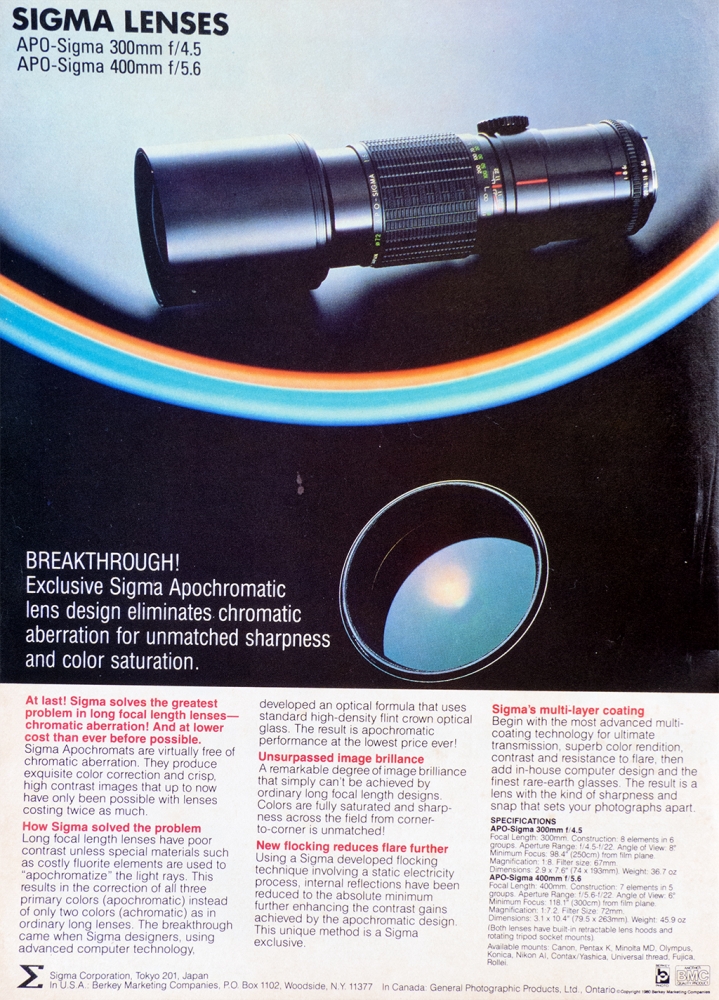


_________________
If raindrops were perfect lenses, the rainbow did not exist. |
|
| Back to top |
|
 |
xaprb

Joined: 28 Jan 2021
Posts: 168
|
 Posted: Sat May 07, 2022 1:20 pm Post subject: Posted: Sat May 07, 2022 1:20 pm Post subject: |
 |
|
xaprb wrote:
If that’s your own copy pictured, I’d love to see sample photos! |
|
| Back to top |
|
 |
marcusBMG

Joined: 07 Dec 2012
Posts: 1304
Location: Conwy N Wales
|
 Posted: Sat May 07, 2022 2:48 pm Post subject: Posted: Sat May 07, 2022 2:48 pm Post subject: |
 |
|
marcusBMG wrote:
xaprb can I use your pics of the lens to add to the lens review section on pentax forums?
_________________
pentax ME super (retired)
Pentax K3-ii; pentax K-S2; Samsung NX 20; Lumix G1 + adapters;
Adaptall collection (proliferating!) inc 200-500mm 31A, 300mm f2.8, 400mm f4.
Primes: takumar 55mm; smc 28mm, 50mm; kino/komine 28mm f2's, helios 58mm, Tamron Nestar 400mm, novoflex 400mm, Vivitar 135mm close focus, 105mm macro; Jupiter 11A; CZJ 135mm.
A classic zoom or two: VS1 (komine), Kiron Zoomlock... |
|
| Back to top |
|
 |
Lloydy


Joined: 02 Sep 2009
Posts: 7785
Location: Ironbridge. UK.
Expire: 2022-01-01
|
 Posted: Sat May 07, 2022 7:01 pm Post subject: Posted: Sat May 07, 2022 7:01 pm Post subject: |
 |
|
Lloydy wrote:
| stevemark wrote: |
Thanks a lot for all this valuable information and the extremely interesting link (which I wasn't aware of).
I have a later version of the Sigma 5.6/400mm APO with Minolta MD bayonet:

As many interesting Sigma lenses from its time, the lens is badly fogged. Therefore, after buying, I simply put it to the attic and forgot about it - for nearly ten years. Yesterday I took it down again, trying to establish some information about its performance. Originally it must have been quite a good lens, having much less CAs than the common 5.6/400mm and 4.5/400mm lenses of its time (e. g. Canon FD 4.5/400 or Konica Hexanon 4.5/400 etc). CAs are about at same level as the Canon nFD 2.8/400mm L, but not as good as the Minolta MC/MD 5.6/400mm (which was a fluorite lens). Detail resolution, however, is not as good as the Canon 2.8/400mm L. Quite good in the center (not too far from the Canon L actually), but quite inferior further out.
I really should clean it up, but other than the bayonet screws i can't see any screw to open the lens!! Interesting mechanical construction indeed ... does anyone have some information on repairing theses lenses? It should be similar to the contemporary* Sigma 7.2/500mm APO lenses which look almost exactly the same, just with a slightly longer barrel!
S
* I don't mean the "Sigma Contemporary" series of lenses here!! |
I was given one of these, identical in OM Mount, in a large collection from a dear friend who died. The lens was mint, in it's case with paperwork. Everything else in the collection was in very good condition and 'well used'. I didn't know he had the lens, he'd never mentioned it, and when I tried it on my A7II could see why - it was awful - so much CA + fringing, and the veiling flare was really bad. There was sharpness for sure, but the lens was just a huge dissapointment. I tried it a couple of times and decided that my old Vivitar ( Hoya ) 400 / 5.6 was far better, indeed..my Soligor 400 / 6.3 was better. I sold the Sigma for £50 at a Camera Fair. I was asking for £100, but £50 was enough to get rid of it!
_________________
LENSES & CAMERAS FOR SALE.....
I have loads of stuff that I have to get rid of, if you see me commenting about something I have got and you want one, ask me.
My Flickr https://www.flickr.com/photos/mudplugga/
My ipernity -
http://www.ipernity.com/home/294337 |
|
| Back to top |
|
 |
stevemark

Joined: 29 Apr 2011
Posts: 3754
Location: Switzerland
|
 Posted: Sat May 07, 2022 7:37 pm Post subject: Posted: Sat May 07, 2022 7:37 pm Post subject: |
 |
|
stevemark wrote:
| Lloydy wrote: |
I was given one of these, identical in OM Mount, in a large collection from a dear friend who died. The lens was mint, in it's case with paperwork. Everything else in the collection was in very good condition and 'well used'. I didn't know he had the lens, he'd never mentioned it, and when I tried it on my A7II could see why - it was awful - so much CA + fringing, and the veiling flare was really bad. There was sharpness for sure, but the lens was just a huge dissapointment. I tried it a couple of times and decided that my old Vivitar ( Hoya ) 400 / 5.6 was far better, indeed..my Soligor 400 / 6.3 was better. I sold the Sigma for £50 at a Camera Fair. I was asking for £100, but £50 was enough to get rid of it! |
Are you sure it was the APO version? There's a non-APO version as well which looks pretty much identical (just the red stripe is missing). I'm a bit surprised by your judgement. Since my copy is quite fogged it has a very low contrast. Nevertheless the APO shown above seems to have not more lateral CAs than e. g. the Canon nFD 2.8/400mm L. Of course the Canon has better resolution in the corners, but the Sigma seems to do pretty well - at least compared to contepomporary non-APO lenses with 400mm focal length.
S
_________________
www.artaphot.ch |
|
| Back to top |
|
 |
eggplant


Joined: 27 May 2020
Posts: 516
|
 Posted: Sat May 07, 2022 7:54 pm Post subject: Posted: Sat May 07, 2022 7:54 pm Post subject: |
 |
|
eggplant wrote:
| stevemark wrote: |
| Lloydy wrote: |
I was given one of these, identical in OM Mount, in a large collection from a dear friend who died. The lens was mint, in it's case with paperwork. Everything else in the collection was in very good condition and 'well used'. I didn't know he had the lens, he'd never mentioned it, and when I tried it on my A7II could see why - it was awful - so much CA + fringing, and the veiling flare was really bad. There was sharpness for sure, but the lens was just a huge dissapointment. I tried it a couple of times and decided that my old Vivitar ( Hoya ) 400 / 5.6 was far better, indeed..my Soligor 400 / 6.3 was better. I sold the Sigma for £50 at a Camera Fair. I was asking for £100, but £50 was enough to get rid of it! |
Are you sure it was the APO version? There's a non-APO version as well which looks pretty much identical (just the red stripe is missing). I'm a bit surprised by your judgement. Since my copy is quite fogged it has a very low contrast. Nevertheless the APO shown above seems to have not more lateral CAs than e. g. the Canon nFD 2.8/400mm L. Of course the Canon has better resolution in the corners, but the Sigma seems to do pretty well - at least compared to contepomporary non-APO lenses with 400mm focal length.
S |
Ill be getting around to this version next, but they briefly made an AF 400mm f5.6 without waiting around to make it APO.
The one in the picture is the manual focus version of this lens.
It's also the one I think has seperation issues, but the optical design is different to the APO dense flint apochromat.
For one, the seperation issue is in the rearmost doublet, not at the front like Ohsone says caused high failure rates of the APO dense flint apochromat.
Ohsone doesn't mention why the optical design changed, or why this previous APO version wasn't converted to AF.
Maybe the high failure rate of the cementing wasn't appropriate for getting an AF 400mm out onto the market quickly.
I really don't have confidence to say... |
|
| Back to top |
|
 |
Lloydy


Joined: 02 Sep 2009
Posts: 7785
Location: Ironbridge. UK.
Expire: 2022-01-01
|
 Posted: Sat May 07, 2022 10:06 pm Post subject: Posted: Sat May 07, 2022 10:06 pm Post subject: |
 |
|
Lloydy wrote:
| stevemark wrote: |
| Lloydy wrote: |
I was given one of these, identical in OM Mount, in a large collection from a dear friend who died. The lens was mint, in it's case with paperwork. Everything else in the collection was in very good condition and 'well used'. I didn't know he had the lens, he'd never mentioned it, and when I tried it on my A7II could see why - it was awful - so much CA + fringing, and the veiling flare was really bad. There was sharpness for sure, but the lens was just a huge dissapointment. I tried it a couple of times and decided that my old Vivitar ( Hoya ) 400 / 5.6 was far better, indeed..my Soligor 400 / 6.3 was better. I sold the Sigma for £50 at a Camera Fair. I was asking for £100, but £50 was enough to get rid of it! |
Are you sure it was the APO version? There's a non-APO version as well which looks pretty much identical (just the red stripe is missing). I'm a bit surprised by your judgement. Since my copy is quite fogged it has a very low contrast. Nevertheless the APO shown above seems to have not more lateral CAs than e. g. the Canon nFD 2.8/400mm L. Of course the Canon has better resolution in the corners, but the Sigma seems to do pretty well - at least compared to contepomporary non-APO lenses with 400mm focal length.
S |
Yes, it was the APO with the red stripe. In the paperwork was the original receipt and it was a very expensive lens - I can't remember how much - but it was seriously dissapointing for the money.
Much more recently I got an AF version in Nikon mount in a kit of Olympus stuff, and because I don't use Nikon ( I have WAY too many mounts and lenses ) I gave it to a friend who I think likes it a lot, he hasn't given it me back so I suppose he likes it. 
_________________
LENSES & CAMERAS FOR SALE.....
I have loads of stuff that I have to get rid of, if you see me commenting about something I have got and you want one, ask me.
My Flickr https://www.flickr.com/photos/mudplugga/
My ipernity -
http://www.ipernity.com/home/294337 |
|
| Back to top |
|
 |
xaprb

Joined: 28 Jan 2021
Posts: 168
|
 Posted: Sun May 08, 2022 5:20 pm Post subject: Posted: Sun May 08, 2022 5:20 pm Post subject: |
 |
|
xaprb wrote:
| marcusBMG wrote: |
| xaprb can I use your pics of the lens to add to the lens review section on pentax forums? |
Yes, you may. |
|
| Back to top |
|
 |
xaprb

Joined: 28 Jan 2021
Posts: 168
|
 Posted: Sun May 08, 2022 5:30 pm Post subject: Posted: Sun May 08, 2022 5:30 pm Post subject: |
 |
|
xaprb wrote:
I removed the front of mine to take a look at it. The retaining ring screws off easily and then a massive chunk of glass simply lifts out of the front of the lens — three elements cemented together, the middle one quite thick. The cement between the first and second is where the haze is. Alas! This seems like such a high quality lens otherwise.
I have seen some mention of people who are competent to reglue elements suffering from balsam separation, but this doesn’t look like balsam cement. I assume there’s nobody who can fix this, but let me know if I’m wrong, I wouldn’t mind paying to have it fixed.
Of course it is nearly impossible to get a good photo of the haze so that you can really see how hazy it is and where. It’s a milky cloud, which is pretty soft and uniform and extends almost to the edges. The edges, oddly, are clear for a few millimeters around the perimeter. Photo below.
I also have hazed copies of other generations of the Sigma 400s, but the problems I have seen with them are grease that’s atomized and deposited on an element’s surface, not milky cement. Grease condensation is cleanable, although I still haven’t fixed mine.
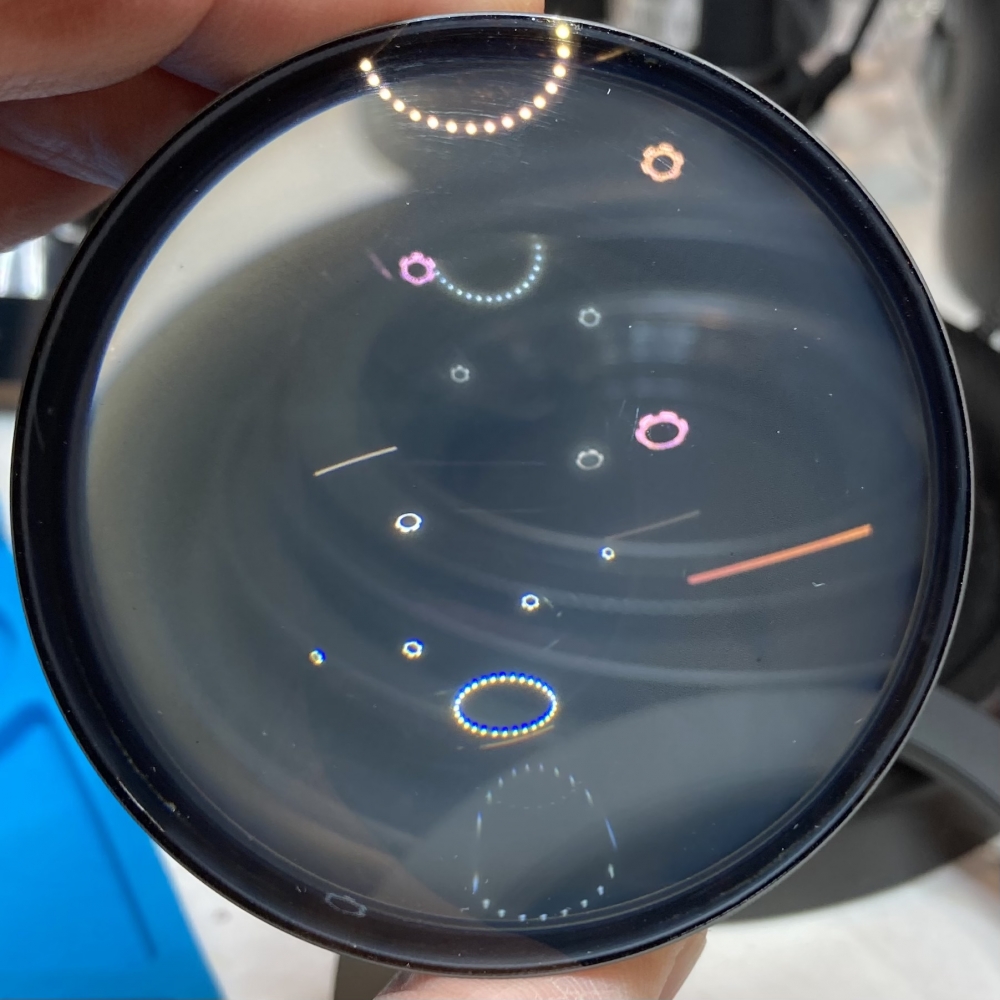 |
|
| Back to top |
|
 |
|
|
